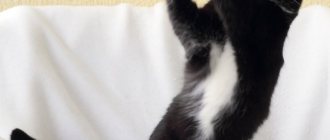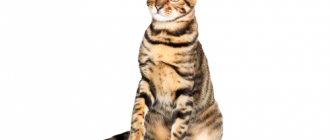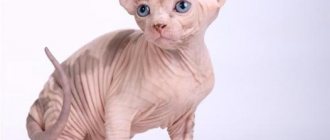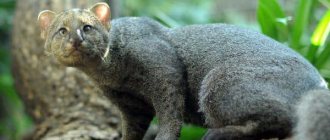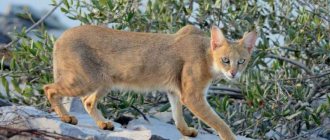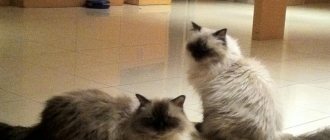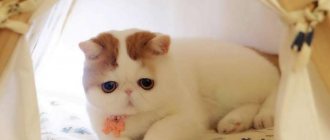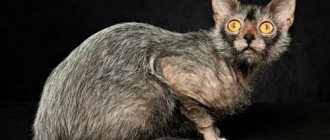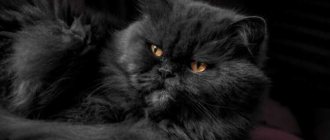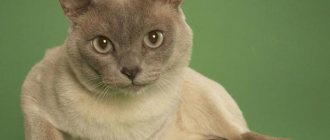Description of the Ragamuffin cat breed
Popularity 23rd among 86 cat breeds
Lifespan:
11-15 years
Height:
28-33 cm
Country of origin:
USA
Average price:
53-79 thousand rubles
Weight:
5-10 kg
Latest articles Cat care
How to trim a cat's claws correctly and easily 01/28/2022 133 0 0
Dog health
How to do an ultrasound for dogs: preparation and procedure 01/28/2022 62 0 0
Advantages and disadvantages
- Pros:
- peaceful and calm character;
- patience, allowing you to get along with children and other animals;
- good health;
- high intelligence, facilitating training and education;
- unlimited trust in a person and devotion.
- Minuses:
- intolerance of loneliness;
- lack of a sense of security and ability to defend oneself;
- undeveloped hunting instinct;
- heavy shedding;
- increased vulnerability to stress.
Ragamuffin training
Raising a breed is a pleasant process for the owners and the pet. The cat is easy to train. Thanks to his flexible, calm character, he quickly accepts commands. With a little patience, you can teach your animal some simple tricks.
Ragamuffin is quick-witted and quickly understands the purpose of the toilet tray and scratching post. It is recommended to start training from the first months of life.
It is not recommended to leave your cat outside unattended after training. Gullibility often ends in injury - many dangers await your pet outside the premises. The cat's peaceful nature leaves no chance in a fight with yard animals.
The Ragamuffin is a breed that will not cause trouble to its owners. Proper care and education are enough to raise a beautiful large cat. The animal will definitely thank you for your care with pleasant moments, loyalty, and playfulness.
History of the origin of the Ragamuffin breed
Ragamuffin is a consequence of a large-scale scandal between ragdoll breeders from the United States that occurred in 1994. The reason for the incident was the introduction of total control and mass bans on experimental matings. This decision was made by Ann Baker, an American breeder and founder of the Ragdoll breed.
In 1971, the enterprising lady created her own association IRCA (International Ragdoll Cat Association) and was the first to register the name “Ragdoll” as a trademark. For several decades, she managed to control the breed standard through strict restrictions for breeders interested in breeding the breed. The latter worked as a franchise with mandatory payment of license fees and remunerations in the amount of 10% of the cost of each kitten sold.
In 1975, some breeders left IRCA and organized their own amateur community RFCI. They set themselves the goal of achieving recognition of the breed from international felinological organizations.
In 1994, several more people left IRCA and chose a different path. They were eager to improve the genetic potential and health of animals. Unlike the first group, they were not too worried about the ban on using the word “ragdoll.”
The breeders named their pets “Ragamuffins” and within a short time updated their appearance and genotype by crossing with Persian, Himalayan and mongrel cats. In 2003, the offspring resulting from this experiment were recognized by the CFA.
INTERESTING!
The original name of the breed (ragamuffin) translates as “ragamuffin,” but American breeders affectionately call their pets sweetmuffins, that is, “sweet muffins.”
What does a ragamuffin look like?
The photo with the Ragamuffin shows that this cat breed is almost no different from the Ragdoll. They are just as cute, fluffy and heavy. The average weight of girls is 5-7.5 kg, and the weight of boys is 5-10 kg.
Muzzle
The wedge-shaped head with soft and slightly convex contours is located on a short and strong neck. The latter's muscularity increases as they grow older. On the short, oval muzzle, voluminous whisker pads and plump cheeks are clearly visible.
Large and expressive eyes are set far apart. The standard allows any color of the iris, subject to its intensity. Even heterochromia is not prohibited.
IMPORTANT!
More stringent requirements apply to the eyes of cats with sepia and mink colors. For the former, they should be golden-green, and for the latter, golden-blue or turquoise.
The neat triangular ears are slightly tilted forward. At their tips there are sometimes small lynx tassels, and inside there is a moderate amount of hairs protruding outwards.
Body type
The ragamuffin's compact body is rectangular in shape. Despite this, it appears nicely round and soft thanks to the increased amount of belly fat. The fat layer that forms by the age of 2 is a feature of the breed that does not affect the health of the animal. But protruding ribs and spine are a serious cause for concern.
The cat's limbs are also heavy and strong. The hind legs are always longer than the front ones, and tufts of wool always appear between the toes.
The medium-thick tail is distinguished by its elegance and thinness closer to the tip. It is covered along its entire length with light, airy fur.
Coat and color
The smooth and silky coat is medium to long. It feels like a rabbit's. The undercoat and spine of the animal are almost identical in length and have an equally dense structure. The longest hair grows in a “collar” around the neck, visually increasing the actual size of the head.
The breed standard allows for any known colors, including white spots and two or three colors on the nose and paw pads. Despite this, the CFA still rejects the temperature-dependent color point.
REFERENCE!
The most expensive color of the ragamuffin is white.
Disqualifying faults
In addition to the color-point color, disqualifying defects include polydactylism, strabismus, various tail defects, short or curly hair. Such ragamuffins are not allowed to compete and are excluded from further breeding.
Breed standard according to CFA classification
Ragamuffins are large animals : males weigh at least 10 kilograms, cats - 7.5-8 kilograms. They have a strong body. Shoulders, chest, croup are wide. The legs are muscular, the front legs are shorter than the hind legs.
Ragamuffins are large animals
The following features are recognized by the standard:
- The head is wide, resembling a slightly rounded wedge. The muzzle is short. The forehead is rounded, the ear pads are large.
- The eyes are large, round, widely set. Their color is not strictly regulated, for example green, amber, blue. It is important that it matches the color.
- Ears are tilted forward. Fur tassels are allowed on rounded ends.
- The tail is long. It is proportional to the body, fluffy, thinning towards the tip.
The coat is fluffy and of medium length. It is very soft to the touch, reminiscent of rabbit fur.
Any colors are allowed. The most popular are bicolor and tabby. White cats and cats are considered very rare.
A distinctive feature of ragamuffins is their fur “breeches” and “collar”.
Ragamuffin cat character
The Ragamuffin breed is a decorative breed, so the cats are completely unsuited to living independently on the street. They do not have a developed hunting instinct or self-defense. If they get lost on a walk, they will never find their way home and will most likely die in some cat fight over territory.
In the absence of aggression in its direction, the “mustache” quickly finds a common language with other pets and becomes attached to them no less than to a person. Even short-term loneliness is difficult for him, so it is better to take your pet with you while on vacation. Changing a cat's location does not frighten him at all if his beloved owner is next to him.
There are no problems when communicating with children. Representatives of this breed have angelic patience and never let out their claws. Some of them even allow you to dress yourself up in dresses and ride in a stroller.
Fluffy heavyweights love to sit on the hands and laps of not only their owners, but also strangers. They have no fear of strangers due to their innate trust in everyone around them.
Despite all their phlegmatic nature, these cats cannot be called outright lazy. They may well play pranks and have a nightly “tygydyk” with climbing the curtains, but they will definitely stop their adventures if one of the household members is against it.
Raising a Ragamuffin
Discreet and intelligent ragamuffins quickly get used to the tray and scratching post, and also master simple acrobatic tricks quite well. When raising them, it is important not to go too far with punishments, as these furry creatures are very vulnerable. Too loud a voice or unreasonable punishment can put a pet into a state of depression, causing a decline in immunity due to stress.
Despite the vulnerability of the animal’s soul, its periodic pranks must be stopped. Behavior problems can be observed at an early age, when the baby is testing the boundaries of what is permitted and bursting with energy.
“ If the kitten is tearing the wallpaper or climbing the curtains, stop it with the command “No” or “No”, using a strict, but not rude intonation. After several repetitions, he will understand that such behavior is unacceptable.
Special attention should be paid to conquering high surfaces. Unlike most mousecatchers, representatives of this breed do not know how to land accurately. Because of this, they are often injured, so jumping outside the scratching post, where there are convenient ladders, should be strictly prohibited.
Appearance and color
Ragamuffin has a large, long body with well-developed muscles. The head is wedge-shaped, with large ears rounded at the tips. Sometimes there may be tassels at the tips of the ears, like those of a lynx. Slanted, oval-shaped eyes, acceptable colors are green, amber green and blue. Strong long legs proportional to the body. The fur is long and silky, there is a collar on the neck, and pants on the hind legs. The undercoat is well developed. Almost any coat color is allowed, but tabby, black colorpoint and bicolor are more common.
Ragamuffin Breed Health
Thanks to the presence of the blood of “nobles,” Ragamuffins have strong immunity and practically no genetic pathologies. With proper care and the absence of chronic disorders, their life expectancy reaches 15 years.
Possible diseases
All the diseases diagnosed in Ragamuffin came from Persian cats. These include:
- Polycystic kidney disease
. It is transmitted from parents by inheriting a defective PKD1 gene, which is responsible for protein synthesis. Accompanied by the gradual proliferation of cystic neoplasms and impaired filtering function of the kidneys. There is no cure, but it can be slowed down by a good ten years.
- Hypertrophic cardiomyopathy
. Refers to genetic pathologies and is characterized by rapid heartbeat with periodic fainting. It is incurable, but with timely consultation with a veterinarian, long-term remission can be achieved.
Allergies, periodontal disease and obesity are much less common in animals. Unlike genetic pathologies, all these diseases can be successfully prevented.
IMPORTANT!
Predisposition to polycystic disease can be determined using a DNA test. If the result is positive, the male or female cat must be excluded from breeding.
Reproductive health and breeding
After receiving CFA recognition, only animals of a similar breed were allowed to breed. Experimental crosses with other varieties are a thing of the past and are prohibited.
Ragamuffins mature late. Their breeding work begins after reaching 3 years of age. Before the meeting, both partners must be vaccinated and treated against parasites.
IMPORTANT!
For cats that are too shy and do not react to the smell of heat, it is better to find an experienced partner in advance. Otherwise, mating will not take place.
Problems with pregnancy and childbirth usually do not arise. The number of kittens in a litter varies from 6 to 7. The fur coat of newborns is always white, and their eyes are bright blue.
If there are no plans to breed the breed, or polycystic disease or hypertrophic cardiomyopathy is detected, the animal is spayed or neutered. The operation is carried out immediately after reaching sexual maturity or as indicated by a veterinarian.
Castration and sterilization of ragamuffins
To relieve the cat from suffering during seasonal heat or in the case of difficult pregnancies and childbirth, the owner should think about castration or sterilization of the ragamuffin. In the first case, the genital organs (testes in cats and ovaries with the uterus in cats) are removed, and in the second, they are bandaged with the possibility of returning reproductive function to the pet in the future.
Castration will help avoid many of Ragamuffin's health problems
The operation must be performed before the purr reaches puberty, and veterinarians advise resorting to this procedure at the age of 6-12 months.
After surgery, the animal must recover within 24 hours, since the operation is performed under general anesthesia.
Postoperative care includes:
- treating an uncovered wound on a cat with terramycin ointment or spray “Aluminicin”;
- on the first day - exclude the animal from being at a great height from the floor in order to avoid falls;
- feeding in small portions in the first 12 hours (for cats) and 24 hours (for cats) after leaving the operating room;
- in case of stool retention for more than 2 days, the animal should take petroleum jelly;
- supplying a castrated or sterilized cat with a special blanket to prevent tearing of the seams (until complete healing within two weeks);
- preventive examination at the veterinary clinic after two to three weeks.
Since castration causes a slowdown in the cat's metabolism, Ragamuffin may begin to gain weight. Therefore, in order to avoid obesity (to which the breed is already prone), you should take care of the balance in the diet and feed the animal only with ready-made food for neutered purrs.
Features of feeding and diet
Ragamuffins love to eat big meals, so it's important to prevent them from becoming dangerously overweight. To do this, you need to calculate the safe daily caloric intake and create the correct feeding schedule.
At the owner's request, the diet can be either natural or dry. Each of them has its pros and cons, which you need to familiarize yourself with before making a final decision.
Natural nutrition
“Naturalka” is good for its ability to control ingredients when preparing dishes and its pleasant taste. Animals get used to regular food much faster than to dry food. There are no problems with the diet menu in case of illness. Despite this rosy picture, a natural diet has many disadvantages:
- loss of time as a result of daily preparation of fresh food;
- the impossibility of independently compiling a balanced menu with sufficient amounts of fats, proteins and carbohydrates;
- high probability of developing vitamin deficiency due to a lack of some vitamins and minerals.
When feeding naturally, vitamin and mineral complexes approved by a veterinarian must be added to the food. Independent selection in such a situation is unacceptable and can result in a surplus of nutrients.
Long-haired giants are very clean. During licking, a large amount of hair gets into their stomach, sticking together into bezoars (wool balls). To remove them, the animal needs to be given fresh herbs or special malt pastes.
Ready-made feed
This option is preferable. Representatives of the breed are prone to weight gain, and in stores you can easily find ready-made food for animals with slow metabolism. Unlike regular food, they contain only healthy ingredients and do not require added vitamins.
The only disadvantage of ready-made feed is the high price. The difference is most noticeable with a mixed diet, when wet pieces of spider meat and canned pates are added to the cat’s “crackers.”
The last 2 products not only cost more than the first, but also run out much faster. Despite this, veterinarians recommend this type of feeding as a preventive measure for dental diseases. Hard kibble protects teeth from tartar formation, and soft food reduces stress on the gums.
If you decide to choose ready-made food, take care of the animal’s drinking regime. Lack of fluid in the body can lead to the formation of urinary stones, so make sure your pet drinks his quota. This can be easily checked using a measuring cup.
Care and maintenance
Ragamuffins should absolutely not be allowed outside the apartment without supervision. Unlike the Norwegian Forest Dog and the Bengal, they do not need walks and can easily spend their entire lives without leaving their house or apartment.
Grooming
Despite the luxurious fur, caring for mustachioed giants is quite simple. Their coat is not prone to matting and practically does not shed. To maintain a neat appearance and remove dead hair, it is enough to brush your pet’s hair just once a week.
Daily brushing is only relevant during shedding. In kittens it lasts about a year, starting at 5 months. At a later age, molting occurs in autumn and the period from February to April. More frequent renewal of the fur coat is possible if the room temperature is too high.
For long-haired breeds, long-toothed combs are suitable. They glide well through the coat and help detangle hairs. After the procedure, the fallen hairs are removed either with a special napkin or with a damp hand.
Hygiene
All representatives of the breed are bathed when dirty with a special shampoo and conditioner for long-haired cats, but not more than once every 4-6 months. Washing outside the schedule is possible before a cat show, after repairs, or under other circumstances associated with a large amount of dust and dirt.
The most unpleasant procedure is brushing your teeth. Few animals perceive it adequately, so as an alternative, you can give your pet solid treats in the form of sticks and sausages. They eliminate unpleasant odors and remove plaque that accumulates after eating. Despite the convenience, it is important to understand that advanced cases can only be treated with ultrasonic cleaning under sedation.
If periodically brushing your teeth on your own doesn’t scare you, purchase any veterinary toothpaste and a special toothbrush designed for animals. To maintain cleanliness of the oral cavity, the procedure will have to be carried out 1-2 times a month for 3 minutes.
The pet's eyes are cleaned of plaque every day, and wax is removed from the ears once a week. In both cases, use regular cotton pads moistened with warm water. Special lotions that can be purchased at a pet store or veterinary pharmacy are also suitable for cleaning ears.
Catering
Ragamuffins, although lazy, are great eaters. Therefore, the owner will have to strictly control the portions given out and not allow the pet to “bite.”
There are two feeding options: special ready-made food or hand-cooked food. Each has both pros and cons.
Natural products
A balanced menu includes:
- Meat: beef, veal, rabbit, turkey (at least 30 grams for a kitten and 120 grams for an adult). There is no need to boil it, just pour boiling water over it. Give 3-4 times a week.
- Boiled liver, hearts, ventricles, minced chicken necks. Liver - no more than once a week. The rest - 2-3 times.
- Fish - only sea fish (trout, salmon, salmon, cod, trout) and no more than once a week (there is a risk of developing urolithiasis). It is allowed to feed the cat shrimp and squid from time to time.
- Fermented milk products (ryazhenka, natural yogurt, cream, kefir, sour cream, cottage cheese, cheese): low-fat, without harmful additives and dyes. Can be given every day.
- Liquid porridges: liquid, oatmeal, semolina, buckwheat, millet. Not with milk, but with water (semolina porridge with water is fed to kittens up to 3 months old). Be sure to add a few drops of vegetable oil to the prepared food.
- Eggs (chicken and quail) – a couple of times a week. From chicken - only the yolk and boiled.
- Boiled or stewed vegetables: cauliflower, carrots, green beans. Give 1-5 times a week, adding to porridge. Sprouted oats, wheat, barley, young nettle leaves (scalded with boiling water) are useful.
- Dry brewer's yeast and vitamins are given in agreement with the veterinarian.
It is prohibited to give:
- Poultry (goose, duck), also pork and lamb;
- Bones, fat, skin;
- Whole cow's milk;
- Salt, sugar, spices, seasonings, mayonnaise, sauces;
- Sweet, smoked, baked goods, flour, salty, fried;
- Human canned food, sausages, frankfurters, small sausages;
- Peas, soybeans, beans, grape potatoes, avocados, bananas;
- Vitamins and supplements for people.
The average cost of a ragamuffin kitten is 50,000 – 70,000 rubles. But this is in the USA. Add the cost of shipping and the reseller's commission.
Pictured are kittens of the Ragamuffin breed.
Recommended food
Natural food, objectively speaking, is better than any food. But in modern life it is not always convenient to cook every day, and sometimes it is difficult to find time. That’s when ready-made food comes to the rescue. There are 4 groups: economy, premium, super-premium and holistic.
Economy
Economy food groups Friskies, Whiskas, Perfect Fit are the cheapest, but also the most stupid. Behind general formulations such as “cereals and products of plant origin”, “meat and its derivatives”, “poultry meal”, protein-poor remains of meat production, corn and similar components are hidden. But what is there in abundance is flavor enhancers, dyes and preservatives of unknown origin.
Premium
Premium food: Safari, Flatazor, Royal Canin are a step higher, although in essence they are not far removed from economy food.
The word “meat” can hide any processed product (most often it is skin, tripe, and bones), vegetable proteins are used - wheat and corn (and they often cause allergies), antioxidants and preservatives are not completely safe.
Super premium
Super-premium food is much more trustworthy. These are Trainer, ProSeries, Eminent. First, they use oats, rice, barley or potatoes instead of corn gluten gluten. Secondly, antioxidants and preservatives are natural (rosemary, mixtures of tocopherols). And the percentage of meat ingredients, vegetables and vitamins is much higher.
Holistic
And finally, holistic foods are the foods that occupy a leading position. They contain: dehydrated and fresh meat and fish; rice or lentils; safe preservatives; fresh fruits, vegetables and berries. In addition to the above, a good vitamin and mineral supplement. Examples: Naturea, Power of Nature, Pronature Holistic.
Expert opinion
Dusheba Vera Ivanovna
In 2010, she graduated from the Moscow State Academy of Veterinary Medicine named after K.I. Scriabin with honors, specializing in veterinary medicine. I regularly attend veterinary conferences, congresses, and webinars.
When choosing ready-made food, remember: the cat should always have access to water without restrictions. Change it 2 times a day: morning and evening. Water – at a comfortable temperature (not cold or hot), clean (distilled or settled).
Below are recommended super-premium foods. Links with the names of the food are clickable, on them you can, within our website, read the descriptions of the food and read reviews from owners of Ragamuffin cats.
| Super premium | Holistic | Super premium |
| Blitz | Farmina N&D | Fitmin For Life |
Tips for choosing a kitten
The final color of “cherubs” is formed only by 4 months, so it is not advisable to get acquainted with kittens before this period. First of all, you need to check the documents of the nursery. He must be licensed by ACFA and CFA. It is equally important to evaluate the living conditions of the animals. If there is a lot of dirt around, contact another breeder.
When meeting a kitten directly, use the following recommendations:
- Make sure there are no signs indicating the presence of illness. Watery eyes, unpleasant odor from the fur or from the mouth, constant scabies, dirt under the tail and other alarming symptoms require mandatory isolation. It is not prohibited to get sick in the nursery, but to avoid infection, sick animals must be kept in a separate room.
- Study the length of the tail. Most kittens have a short length, but not cherubs. The impressive length of the tail relative to the body is observed already in early childhood and is clearly visible visually.
- Check the brightness and saturation of the iris. The higher they are, the better. It is also possible for the eyes to remain blue for up to 2 months, but most often the color changes within 5 weeks after birth.
- Try to communicate. A purebred kitten should not show cowardice or aggression. Curiosity and slight timidity are encouraged.
- Take the baby in your arms. The right Ragamuffin will immediately melt into a hug and hang like a rag doll, just like a Ragdoll. Remember that a purebred kitten should not struggle or show other signs of excessive activity.
Feel free to ask to meet the babies' parents and also check their breeding documents. Thanks to this, you will be able to evaluate the appearance of animals, the adequacy of their behavior, pedigree and the presence of diseases confirmed by a doctor.
How to choose the right kitten
Ragamuffins are quite rare and expensive cats. Therefore, you need to buy them only from trusted breeders or certified nurseries, the largest of which are concentrated in the USA. Before purchasing, it is recommended to make sure that you have documents about the breed and evaluate how well the fluffy kitten’s appearance meets the standard.
First of all, you need to pay attention to the eye color of the little Ragamuffin. The richer and brighter the shade of the iris, the better. Purebred kittens have a strong rectangular chest, a long tail and powerful hind legs.
On a note. All Ragamuffin kittens are born with white fur. Their future color begins to appear as they grow older. Therefore, you should buy a baby of this breed no earlier than 16 weeks of age.
Kitten care
Typically, kittens of this breed are booked in advance, which means that future owners have enough time to prepare their home for the arrival of their furry pet. For him they buy:
- bowls for food and water;
- grooming tools;
- hygienic cosmetics;
- toys;
- bed;
- scratching post;
- tray and filler.
To prevent the kitten from being injured in the process of exploring a new place of residence, small objects, indoor plants, household chemicals and wires are removed from it. Also, for safety reasons, the little Ragamuffin is denied access to open windows and large appliances such as ovens and washing machines.
To prevent digestive problems associated with stress from a change of environment, at first the fluffy kitten is fed what he is accustomed to from the breeder. New foods are introduced into the little Ragamuffin’s diet gradually, carefully observing the reaction of his body. The feeding regimen is selected taking into account the age of the pet:
- up to 3 months – 5-6 times a day;
- 3-6 months – 4 times a day;
- 6-12 months – 3 times a day.
From the age of one year, Ragamuffin is transferred to twice feeding.
How much does a ragamuffin cat cost?
The majority of nurseries are located in the USA. Single offers from breeders who have received official breeding permission can also be found in Canada, England, Austria, Bulgaria, the Netherlands and South Korea.
In Russia, they know even less about the breed than about the Ragdoll. The same applies to the CIS countries, so you can only buy a purebred pet abroad.
The average price for ragamuffin in rubles is 53-79 thousand rubles. The problem is that it does not include the cost of transporting the animal and the commission to the reseller.
Do you like the article? 0
Interesting Facts
During the short period of existence of ragamuffins, many interesting things have been associated with them:
- Cats of this breed have a very gentle character. Therefore, American breeders gave them the playful nickname sweet muffins, which translated from English means “sweet cupcake.” Ragamuffins are also called Teddy bears in the form of a cat.
- Among the representatives of this breed there are many heavyweights, whose body weight exceeds 9-10 kg.
- With age, the fluffy fur of Ragamuffins changes structure and loses its natural shine. The cat's coat becomes more porous and dull. Therefore, representatives of the breed look much darker in old age.
